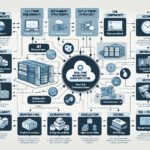Configuring IT infrastructure for containerized applications involves creating a robust, scalable, and flexible environment that supports container orchestration, networking, storage, and security. Below is a step-by-step guide for configuring an IT infrastructure for containerized applications:
1. Assess Requirements
- Workload Analysis: Analyze the nature of your containerized applications (stateful or stateless, resource-intensive, etc.).
- Scalability: Determine your scalability needs (horizontal and vertical).
- Performance: Identify CPU, memory, I/O, and GPU requirements.
- Security: Define security needs (isolation, access control, etc.).
- High Availability: Plan for redundancy and failover capabilities.
2. Choose Container Orchestration Platform
- Kubernetes (K8s): The most popular container orchestration platform.
- Alternatives: Docker Swarm, Red Hat OpenShift, Amazon ECS, or HashiCorp Nomad.
- Ensure your platform is compatible with your applications and provides the necessary features.
3. Infrastructure Design
- Bare Metal or Virtualized: Decide whether to run containers on physical servers or virtual machines.
- For large-scale deployments, bare metal provides better performance.
- Virtualized environments (e.g., VMware vSphere, Hyper-V, Proxmox) offer more flexibility.
- Cloud, On-Prem, or Hybrid: Choose the deployment type based on your business needs.
- Cloud providers like AWS, Azure, or Google Cloud provide managed Kubernetes services.
- On-premises solutions provide more control over the infrastructure.
4. Compute Resources
- Servers: Use high-performance servers with sufficient CPU, RAM, and GPU resources.
- GPUs: If running AI/ML workloads, configure GPU-enabled servers (e.g., NVIDIA A100, T4, or V100 cards). Ensure Kubernetes supports GPU scheduling (via NVIDIA GPU Operator or similar tools).
- CPU/Memory Reservation: Allocate sufficient resources per node to handle container workloads.
5. Networking
- Cluster Networking: Use a Container Network Interface (CNI) plugin (e.g., Calico, Flannel, Cilium, Weave Net) for intra-cluster communication.
- Load Balancing: Configure load balancers (e.g., MetalLB, cloud-native load balancers) for external and internal traffic.
- Ingress Controller: Deploy an ingress controller (e.g., NGINX, Traefik) to manage external HTTP/HTTPS traffic.
- DNS: Ensure DNS resolution for services within the cluster.
- Service Mesh: Consider implementing a service mesh (e.g., Istio, Linkerd) for advanced traffic management, security, and observability.
6. Storage
- Persistent Storage: Use a Container Storage Interface (CSI) driver to provide storage for stateful applications. Common options include:
- On-Prem: Ceph, NFS, GlusterFS, VMware vSAN.
- Cloud: Amazon EBS/EFS, Azure Disk/File, Google Persistent Disk.
- Dynamic Provisioning: Enable dynamic volume provisioning to automate storage allocation.
- Backup: Set up backup solutions for persistent volumes (e.g., Velero, Kasten).
7. Security
- Container Security:
- Use trusted container images.
- Scan images for vulnerabilities with tools like Trivy or Aqua Security.
- Access Control:
- Use Role-Based Access Control (RBAC) in Kubernetes to limit access.
- Implement network policies for pod-to-pod communication.
- Secrets Management: Use tools like HashiCorp Vault, Kubernetes Secrets, or AWS Secrets Manager.
- Isolation: Run containers in isolated namespaces and consider using PodSecurityPolicies or Open Policy Agent (OPA).
8. Monitoring and Logging
- Monitoring: Deploy monitoring tools (e.g., Prometheus, Grafana) to track cluster and application performance.
- Logging: Use centralized logging solutions (e.g., Elasticsearch, Fluentd, Kibana (EFK stack) or Loki) for troubleshooting and compliance.
- Tracing: Implement distributed tracing tools (e.g., Jaeger, Zipkin) to analyze application performance.
9. Automation and CI/CD
- Automation: Use Infrastructure as Code (IaC) tools like Terraform, Ansible, or CloudFormation to automate cluster provisioning.
- CI/CD Pipelines: Integrate CI/CD pipelines (e.g., Jenkins, GitLab CI, ArgoCD) to automate container builds, testing, and deployment.
10. Backup and Disaster Recovery
- Cluster Backup: Use tools like etcd snapshots (for Kubernetes control plane) or Velero (to backup both resources and persistent volumes).
- Disaster Recovery: Plan for cluster restoration in case of failure.
11. Load Testing
- Perform load testing (e.g., with tools like Apache JMeter or k6) to ensure the infrastructure can handle the expected workload.
12. Compliance and Governance
- Adhere to industry standards (e.g., GDPR, HIPAA) for security and data privacy.
- Use tools like Open Policy Agent (OPA) or Kyverno to enforce compliance policies within the cluster.
Example IT Infrastructure for Kubernetes
- Compute: High-performance servers with Intel Xeon or AMD EPYC processors and NVIDIA GPUs for AI/ML workloads.
- Storage: Ceph for dynamic provisioning of persistent volumes.
- Network: Calico CNI for secure and scalable networking.
- Backup: Velero for cluster and application backups.
- Monitoring/Logging: Prometheus and EFK stack for observability.
By carefully planning and implementing the above components, you can build a scalable, secure, and efficient IT infrastructure for containerized applications. Let me know if you need more details or recommendations!





